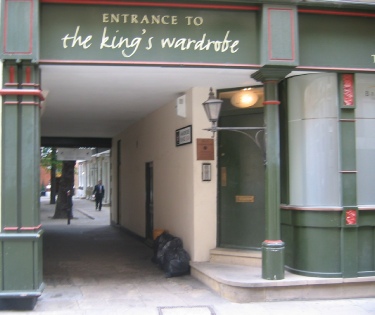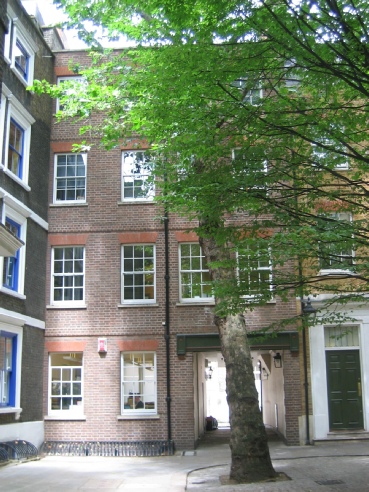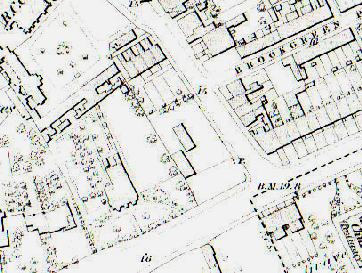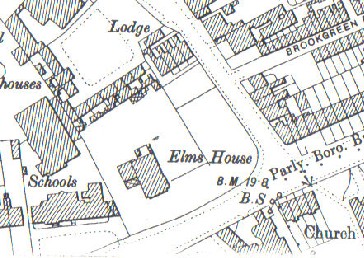

Early years
The eldest child of the solicitor James Newbon and his wife Jane, James Shelton Newbon took his unusual middle name from the married surname of his father’s elder sister Susannah -
James Shelton Newbon was clearly well educated, although it is not known where he received his schooling. He followed his father into the law, becoming his apprentice in 1822, and then after James’s early death in 1830 took over his law firm.
James Shelton Newbon married Ann Brockelbank on January 23rd 1831 at Greenwich, Ann’s home town. The couple had 8 children, 7 sons and a daughter: James Thomas Peter, Thomas, Henry George, Annie, Charles Evans (whose middle name was the surname of his father’s business partner, John Llewellyn Evans), Joseph, Clarence Brockelbank (whose middle name was his mother’s maiden surname) and Septimus Baily (Septimus presumably because he was the couple’s 7th son). Two of the children died in infancy: Annie (the only daughter) and Clarence. The eldest child James was born in the parish of Christchurch, Surrey (in Southwark); the next 4 were born in the City of London (possibly at 1 Wardrobe Place); the 3 youngest children were born at Blackheath in Kent, which is situated very close to Greenwich. Some time after the birth of Septimus in 1846, James Shelton Newbon and his family moved to Elms House, High Road, Hammersmith, where they can be found on the 1851 and 1861 censuses. Nothing now remains of Elms House, seemingly not even a photograph. One photograph of the neighbouring property, dating from around the turn of the century, shows what must be the top left-
James Shelton Newbon on the census
In 1841 James Shelton Newbon’s family can be found living on the south coast, at St Mary in the Castle, Hastings. 3 servants are listed, as well as James’s 20-
The Newbon family in local records
Another series of family snapshots can be found among the archives of the Turnham Green Devonshire Cricket Club, West London. Two surviving match reports from 1856 and 1857 mention members of the Newbon family, presumably all sons of James Shelton Newbon. On Saturday 6th September 1856 the Turnham Green Club played the Gentlemen of Chiswick and the archives record that ‘J.Newbon Esq. made some brilliant hits’ and ‘G.H.Newbon Esq. [presumably in fact Henry George Newbon?] also displayed a fine style of batting.’ On June 15th the following year the team played a match against Kilburn in which ‘T.Newbon Esq. played extremely free and contributed 21 to the score’ and ‘H.Newbon Esq. played well for 16.’ The title of ‘esquire’ is worthy of note, since it was accorded to almost no other players in any of the match reports during the whole of those two years, and is thus evidence of the Newbons’ high social standing.
The local newspaper of the day, the West London Observer, contains one interesting little article, which throws some light on the sort of lifestyle the Newbons must have enjoyed at Hammersmith:
The Newbon family in other records
James Shelton Newbon’s family seems to have acquired somewhat literary tastes during the 19th century. His son Joseph, so concerned with the preservation of heritage, published A History of the Parish of St Ann, Blackfriars, in the Ward of Farringdon Within, in the City of London in 1876. Other family publications do not have quite the same original content as Joseph’s history: his elder brother Charles Evans Newbon translated a French legal text, which was issued in London in 1870, and Charles Evans Newbon’s son Herbert Alexander compiled a series of parliamentary proceedings which were published in 1896. All of these works can now be found in the British Library.
Several members of James Shelton Newbon’s family also had letters and articles published in the national press, expressing their views on various topical matters. The following, for example, appeared in The Times:
The second 1896 reference is an impassioned letter that Joseph wrote, prompted by a proposal to demolish Wardrobe Place – proof of how attached the Newbons were to the home of their ancestors. History and the preservation of tradition were obviously of great importance to him.
Later years
James Shelton Newbon died on February 3rd 1863 at Elms House, Hammersmith of ‘Disease of the liver and Congestion of the brain’, leaving the large sum of £25,000 in his will. His death was reported in the deaths column of The Times. His widow Ann died 3 years later on December 1st 1866, leaving a complicated will to provide for all her younger children and for the families of 2 of her own brothers. James and Ann were buried in West Brompton Cemetery, London SW10, where their grave can still be found today. It is in the shape of a raised tomb, with an inscription in an elaborate gothic script around the sides that is now very hard to read. On the top is an intricate cross. The style is far more decorative than that of any of the neighbouring graves and would suggest that the Newbons had a taste for the Victorian gothic style. The one tantalisingly small view of Elms House we have backs this up.
The lives of James Shelton Newbon’s children
At least 4 of James Shelton Newbon’s sons followed him into the legal profession, with two (Thomas and Joseph) joining their father’s firm:
|
|
Charles Evans Newbon chose a career as a barrister rather than as a solicitor, practising at 3 North King’s-
|
|
|
It is likely that Joseph Newbon became a partner in the family firm while still in his 20s, or, if not, his early 30s. This may have happened immediately after the death of his brother Thomas in 1871, or, more likely, earlier still, soon after the death of James Shelton Newbon in 1863. In 1864 Joseph was one of the witnesses of the will of his maternal uncle Lemuel Brockelbank, and at Lemuel’s death in 1869 Joseph acted as one of the executors. In the 1864 will Joseph’s address is given as 28 Nicholas Lane, Lombard Street. Interestingly, the other witness was George Berry of the same address, ‘clerk to Messrs Newbon, Evans & Co.’ -
|
|
|
Two of James Shelton Newbon's children died young: a son, Clarence Brockelbank Newbon (1843-
|
The Newbon family obviously felt a strong attachment to the area of Doctors’ Commons, where James Shelton Newbon had been born. Joseph Newbon wrote A History of the Parish of St Ann, Blackfriars, in the ward of Farringdon Within, in the City of London, which was published in 1876 by Judd & Co. of St Andrew’s Hill (the road in which the Newbon family had lived earlier in the century).
|
Born: |
1806 (Blackfriars) |
Died: |
February 3rd 1863 (Hammersmith) |
|
Father: |
James Newbon (1778- |
Mother: |
Jane Newbon (formerly Cobbett) |
|
Spouse: |
Ann Brockelbank (c.1813- |
Occupation: |
Solicitor |
|
Children: |
James Thomas Peter Newbon (1832- Henry George Newbon (1836- Septimus Baily Newbon (1846- |
||
To Top of Page
|
1846 |
January 3rd |
James Shelton Newbon on the Watermen’s and Lightermen’s Company |
|
|
January 30th |
James Shelton Newbon on the Watermen’s Steampacket Company [of which he was secretary at the time] |
|
1865 |
August 24th |
Newbon and Starkey on the removal of Law cases |
|
1881 |
June 22nd |
Joseph Newbon on municipal reform |
|
1883 |
October 1st |
Charles Evans Newbon – letter on the injustice to Alderman Hadley by the Court of Aldermen |
|
|
November 6th |
Joseph Newbon on the election of the Lord Mayor |
|
1894 |
May 16th |
Charles Evans Newbon on Sir Robert Peel and the House of Lords |
|
1896 |
May 26th |
Charles Evans Newbon on the American Mail Service |
|
|
November 26th |
Joseph Newbon on an ancient landmark threatened |
|
1912 |
August 27th |
Charles Evans Newbon on Sir Walter Raleigh |
|
1913 |
June 10th |
Herbert Newbon on the preservation of Crystal Palace |
|
1919 |
February 13th |
Charles Evans Newbon on Shakespeare and the Davenants |
|
1841 |
- |
St Mary in the Castle, Sussex, with his family |
|
1851 |
- |
at home with family and 4 servants (including one manservant) at Elms House, Hammersmith |
|
1861 |
- |
in Brighton with eldest son (his wife and 4 youngest sons were at home in Hammersmith |


Civic duties
In the London trade directory of 1851 James Shelton Newbon is listed as vestry clerk of both St Andrew-
Professional life
James Shelton Newbon first appears in the Law Lists in 1829, the year he completed his apprenticeship with his father’s firm and shortly before he took over the business. By 1840 James Shelton Newbon had gone into partnership with welsh-
James Shelton Newbon in fact inherited 1 Wardrobe Place from his father-


| Site Map |
| Background to my research |
| Background to the surname NEWBON |
| Documents available and sources used |
| Name index |
| Walter Newbon's descendants |
| Northamptonshire Newbons |
| Redbourn, Hertfordshire |
| James Shelton Newbon |
| Henry Newbon |
| The Crickmer family |
| The Newbon Family and the City of London |
| Charles Evans Newbon |
| Joseph Newbon |
| The Brockelbank Family |
| The United Wards' Club of the City of London |
| John Newbon |
| The Children of John Newbon |
| World War I |
| Walter Thomas Newbon |
| The Newbon Family of Northamptonshire |
| Northamptonshire, the early home of the Newbon Family |
| King's Cliffe |
| Records of King's Cliffe |
| Maps of King's Cliffe |
| Links with elsewhere |
| News 2014 |
| News 2013 |
| News 2012 |
| News 2011 |
| News 2010 |
| News 2009 |
| News 2008 |
| Updates |
| To do |
| Guestbook |